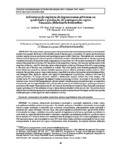Por favor, use este identificador para citar o enlazar este ítem:
http://www.alice.cnptia.embrapa.br/alice/handle/doc/630314| Título: | Influência de espécies de leguminosas arbóreas na qualidade e produção de pastagem de capim Marandu (Brachiaria brizantha). |
| Autor: | SILVA, L. L. G. G. da  DIAS, P. F.   SOUTO, S. M.   RESENDE, A. S. de   COLOMBARI, A. A.   MIRANDA, C. B.   FRANCO, A. A.   |
| Afiliación: | Lusimar Lamarte Fonzaga Galindo da Silva, UFRRJ; Paulo Francisco Dias, PESAGRO-EES-RIO; Sebastião Manhães Souto, Embrapa Agrobiologia; Alexander Silva de Resende, Embrapa Agrobiologia; A. Alves Colombari, UFRRJ; César Behling Miranda, Embrapa Gado de Corte; Avílio Antonio Franco, Embrapa Agrobiologia. |
| Año: | 2008 |
| Referencia: | Archivos Latinoamericanos de Producción Animal, Mayaguez, v. 16, n. 2, p. 48-56, 2008. |
| Descripción: | The silvopastures systems promote the production and environment protection, several benefits should to be reached. However, to that benefits result in the tree-grass association, it is necessary that the trees provide, mainly, increase production and quality grass grown below their tops. The objetive was, evaluate the influence of four leguminous arboreal species in seventeen variables of Brachiaria brizantha cv. Marandu growing at different distances (D) from the trunk of leguminous of these trees: Dl = 50 cm from the trunk; D2= half of the radius of the projection of the top; D3= the radius of the projection of the top; D4= one and half the radius of the projection of the top; and D5= twice the radius of the projection of the top. Distances (D4 e D5) corresponding to the areas out of the tops and considered as controls. The used species were Samanea guachapele (albizia), Acacia holosericea (olosericea), Mimosa tenuiflora Gurema preta) e Mimosa artemisiana Gurema branca). Were evaluates the variables in grass: tenor crude protein, digestibility in vitro of dry matter, neutral detergent fiber, acid detergent fiber, lignin in sulfuric acid, lignin in permanganate of potassium, cellulose, silica and dry matter production. To analyse the datas utilized a multivariate analysis method, the factor analysis. The rotative factor Fl, wich explained the highest variance percentage of datas, associated to the results of the factorial scores, showed that the leguminous arboreal specie A. holosericeaproporcioned the majors accumulation of dry matter, protein, digestibility in vitro of dry matter in aereal part of Marandu grass, growing in distances more next of the trunk. The rotative factor Fl also showed that the lowest values for these variables were found in grass growing out of the influence of cup is specie Mimosa tenuiflora in the area no tree. The partial results indicate that the arboreal leguminous Acacia holosericea (olosericea) proportioned the higher quality and quantity in Marandu grass, when it growed under influence of its top. |
| Thesagro: | Arborização Brachiaria Brizantha Cupim Pastagem |
| Palabras clave: | Leguminosa florestal Produção da biomassa |
| Notas: | Parceria: UFRRJ; PESAGRO; Embrapa Gado de Corte. |
| Tipo de Material: | Artigo de periódico |
| Acceso: | openAccess |
| Aparece en las colecciones: | Artigo em periódico indexado (CNPAB)  |
Ficheros en este ítem:
| Fichero | Descripción | Tamaño | Formato | |
|---|---|---|---|---|
| Influenciadeespeciesdeleguminosasarboreasnaqualidadeeproducao.pdf | 127,3 kB | Adobe PDF |  Visualizar/Abrir |









